#paris 1833
Explore tagged Tumblr posts
Text
Being the son of marshal Soult ...

... may not always have been fun for young Napoléon Hector. Not only because growing up under such an overbearing personality could be considered quite challenging in the first place, but also because Soult senior, at all times of his career, had a real knack for making enemies all over the place. This was especially true for the last period of his life, that he spent as minister in the July Monarchy.
The July Monarchy, from my very layman perspective, seems to have been a compromise by its very nature: a bit of First Empire nostalgia for the bonapartists, a bit of constitution and parliamentary debates for the republicans, a bit of a Bourbon monarch for the royalists. And of course, as is always the case with compromises, everybody hated it.
On 13 May 1833, Marshal Soult, as minister of War, in parliament proposed some changes to the army administration: Conscripts were to serve for three years before returning to their homes and forming an army reserve that could be called upon in times of need. This proposal was vehemently critisized by the bonapartist party, namely one former colonel Armand de Bricqueville, who saw in this change a deliberate attempt to destroy what he called "regimental spirit", the lack of which in the long run would make the army nothing but an obedient tool in the hands of the government. (Which apparently was a horrible thing.) Bricqueville, you have to give it to him, managed to put into his speech every personal insult against Soult he could think of, from accusing him of trying to bring back the Restauration, of having supported the ultra-royalists, to having been the cause for the defeat at Waterloo, even hinting at Soult having betrayed Napoleon. Some excerpts:
[...] Ah, you're right, weaken the country's forces, because they're all against you! [Call to order] Break the national instruments, [...] bring about the Restoration, that is your task, and probably your goal! [Repeated call to order] [… About Napoleon’s army at Waterloo] Its leaders were tired of war and were no longer physically or morally fit to wage it. Staff were filled with traitors [...] The loss of the battle was mainly due to that inconceivable negligence that led to essential orders not reaching General Grouchy [...], which made everyone say that the victory would have been ours if Marshal Berthier had been the major-general. [Exclamations in the centre, Marshal Soult salutes]. Unfortunately, the man who replaced him had, in 1814, in the service of the Bourbons, mistreated the old army more than anyone else. [New exclamations] He had just become intimately acquainted with the Vendéens and the Chouans of Quiberon […] There are men who, in enemy territory, have made the French name abhorred by their exactions; I could name some who in their rout did not lose a single piece of the gold that victory had brought them; who, as friends of the fine arts, we must do them justice, brought admirable masterpieces to France, and finally brought back treasures on the backs of mules, but not a single caisson or barrel of cannon. [Murmurs]
The last part obviously alluding to Soult’s retreat from Portugal in spring 1809, but mixing it with the retreat from Andalusia in 1812 (that had been anything but a rout).
I guess the overall tone of that debate gets quite clear from those snippets. Interestingly, Soult actually seemed to want to answer, but two of his colleagues prevented him from honouring these personal insults with a reply.
And that’s where Napoléon Hector, the Marquis de Dalmatie, by now 30 years old, takes the stage. Because the next thing Bricqueville received (presumably after many congratulations from his bonapartist colleagues) was a challenge to a duel from Marshal Soult’s son. It was fought on 14 May, and the four witnesses (Clausel and Jacqueminot for Soult Junior, Exelmans and Bacot for Bricqueville) put this official protocol into the Journal de débats of 15 March:
The direct attacks of M. le colonel de Bricqueville against M. the marshal minister of war in his speech of Thursday 13 June in the Chambre des Députés, having made it essential for M. the marquis de Dalmatie to seek satisfaction, a meeting took place this morning in the Bois de Boulogne between these honourable adversaries, who chose the sword as their weapon, and began a fight which lasted more than ten minutes. M. de Dalmatie hit a stone and fell backwards. Monsieur de Bricqueville hurried to offer him his hand and put him back on the right ground. The fight started again. This time, M. de Bricqueville's sword, having become entangled in M. de Dalmatie's after a fairly long struggle, slipped out of his hands. He advanced straight towards his opponent, who eagerly gave him back his weapon. After a rest necessitated by such a vicious attack, the fight resumed; the adversaries rushed at each other and soon came to grips face to face. In this situation, the witnesses, who were, on one side for the Marquis de Dalmatie, Marshal Clausel and General Jacquéminot, and on the other side General Excelmans and Mr César Bacot, Member of Parliament, threw themselves between them and declared that, as men of honour, they should not allow such a stubborn engagement to continue. The two combatants submitted to this decision and went their separate ways, showing each other frank and loyal esteem. Paris, 14 June 1833.
To me this sounds a lot as if all four of the witnesses were mostly there in order to watch the two idiots stumble around a little and to make sure that nobody got really hurt. There are different reports about this incident, some even claiming that Bricqueville actually did injure the marquis de Dalmatie or that the latter was fighting in earnest. Anyway, the official report is the one above.
In how far Soult himself was behind or informed of the duel, I do not know. Gotteri seems to not mention this at all in her book, and Brun de Villeret at the time was not in Paris. Only why Soult himself did not make the challenge seems clear: He was already 64 years old in 1833 and rather not fit for hand-to-hand combat.
But this was not the only incident in which a dissatisfied officer expected the son to stand in for his father: a certain maréchal-de-camp Hulot d’Aussery (or d’Osery; a distant relative of one of Soult’s former aides) that same year asked for an interview with the marquis de Dalmatie and, as soon as he was received, challenged him to a duel, because Soult as minister of War had not made Hulot a lieuténant-général yet, as Soult’s predecessor Gérard had promised. Napoléon-Hector, presumably somewhat confused (he was neither involved in the affairs of the ministry nor was he even part of the military, but had become a diplomat) refused the challenge but promised to talk to his father about it. Soult senior sent one of his aides to Hulot who tried to talk some sense into him, but to no avail. (According to one anecdote, Soult did not take the whole thing very serious, telling Hulot: So sorry, but I only do duels with cannonfire.)
Disgruntled Hulot did not let it go. The minister of the Interior interfered next, telling Hulot to stop that nonsense. Hulot then sent two highly insulting letters to Soult junior, probably hoping Napoléon Héctor would feel offended enough to now accept the challenge. When both father and son Soult instead decided to sigh, shrug and ignore the whole matter, Hulot had the letters published in the republican journal La Tribune:
Marquis of Dalmatia, you are an insolent coward! Wherever I meet you, I will stamp your face with the seal of infamy! If life is dear to you, then live at this price...
Nope. Being the son of marshal Soult, probably not always fun.
14 notes
·
View notes
Text

Hello and welcome to a special edition of Eighteen-Thirties Thursday called "Shaun Doesn't Understand French"!
We have here an 1833 print by Paul Gavarni, with a very 1830s devil (shown by his horns and tail), and two lovely ladies on his arms. It's the title of the piece that I'm questioning: Le Diable hors Barrière.
I can read simple/intermediate texts in French (although I often make mistakes) and initially parsed it as "the devil outside of barriers." Google Translate—I know, I know—translates it as "the devil off the fence." That does seem to make sense in context, it looks like there's a fence in the picture (and in English "off the fence" means finally making a choice or commitment). I thought it might be an idiomatic expression, but I'm turning up nothing except references to this specific print by Gavarni.
There is a sense of "barrière" meaning disreputable place, in reference to tax-evading and somewhat shady business historically located just outside the gates of Paris. q.v. an English book from 1859: "The Paris rogues have, now-a-days, no refuge but hors barrière; that is their only chance; and what they will do when the project already determined on for the removal of the mur d'octroi [a barrier-gate that charged tolls], and the extension of Paris to the fortifications, is carried out, seems difficult to guess."
Am I wildly overanalyzing this, or badly missing a period reference?? Is Gavarni making a joke with some word-play I'm not catching? He loved to use colloquial language and slang and I often struggle with his captions.
#Eighteen-Thirties Thursday#paul gavarni#le diable hors barrière#1833#fashion#language#romantic era#le charivari#paris#i studied french in school and have read many comic books in french#i want to emphasise that i'm not an absolute beginner i'm just an idiot#gavarni's use of 19th century french frequently bedevils me
47 notes
·
View notes
Photo

🐊 Dictionnaire pittoresque d'histoire naturelle et des phénomènes de la nature. v.1 Paris, 1833-[1840]
320 notes
·
View notes
Text

Antoine Vollon (1833-1900) "Espagnol" ("Spaniard") (1878) Oil on canvas Realism Located in the Musée d'Orsay, Paris, France
#paintings#art#artwork#genre painting#male portrait#antoine vollon#oil on canvas#fine art#musée d'orsay#musee d'orsay#museum#art gallery#portrait of a man#spanish#spaniard#clothing#clothes#dogs#animals#1870s#late 1800s#late 19th century
542 notes
·
View notes
Text
What it meant to "do geology" in Hutton's time was to apply lessons of textual hermeneutics usually reserved for scripture [...] to the landscape. Geology was itself textual. Rocks were marks made by invisible processes that could be deciphered. Doing geology was a kind of reading, then, which existed in a dialectical relationship with writing. In The Theory of the Earth from 1788, Hutton wrote a new history of the earth as a [...] system [...]. Only a few kilometers away from Hutton’s unconformity [the geological site at Isle of Arran in Scotland that inspired his writing], [...] stands the remains of the Shell bitumen refinery [closed since 1986] as it sinks into the Atlantic Ocean. [...] As Hutton thought, being in a place is a hermeneutic practice. [...] [T]he Shell refinery at Ardrossan is a ruin of that machine, one whose great material derangements have defined the world since Hutton. [...]
The Shell Transport and Trading Company [now the well-known global oil company] was created in the Netherlands East Indies in 1897. The company’s first oil wells and refineries were in east Borneo [...]. The oil was taken by puncturing wells into subterranean deposits of a Bornean or Sumatran landscape, and then transported into an ever-expanding global network of oil depots at ports [...] at Singapore, then Chennai, and through the Suez Canal and into the Mediterranean. [...] The oil in these networks were Bornean and Sumatran landscapes on the move. Combustion engines burnt those landscapes. Machinery was lubricated by them. They illuminated the night as candlelight. [...] The Dutch East Indies was the new land of untapped promise in that multi-polar world of capitalist competition. British and Dutch colonial prospectors scoured the forests, rivers, and coasts of Borneo [...]. Marcus Samuel, the British founder of the Shell Transport and Trading Company, as his biographer [...] put it, was “mesmerized by oil, and by the vision of commanding oil all along the line from production to distribution, from the bowels of the earth to the laps of the Orient.” [...]
---
Shell emerged from a Victorian era fascination with shells.
In the 1830s, Marcus Samuel Sr. created a seashell import business in Houndsditch, London. The shells were used for decorating the covers of curio boxes. Sometimes, the boxes also contained miniature sculptures, also made from shells, of food and foliage, hybridizing oceanic and terrestrial life forms. Wealthy shell enthusiasts would sometimes apply shells to grottos attached to their houses. As British merchant vessels expanded into east Asia after the dissolution of the East India Company’s monopoly on trade in 1833, and the establishment of ports at Singapore and Hong Kong in 1824 and 1842, the import of exotic shells expanded.
Seashells from east Asia represented the oceanic expanse of British imperialism and a way to bring distant places near, not only the horizontal networks of the empire but also its oceanic depths.
---
The fashion for shells was also about telling new histories. The presence of shells, the pecten, or scallop, was a familiar bivalve icon in cultures on the northern edge of the Mediterranean. Aphrodite, for example, was said to have emerged from a scallop shell. Minerva was associated with scallops. Niches in public buildings and fountains in the Roman empire often contained scallop motifs. St. James, the patron saint of Spain, was represented by a scallop shell [...]. The pecten motif circulated throughout medieval European coats of arms, even in Britain. In 1898, when the Gallery of Palaeontology, Comparative Anatomy, and Anthropology was opened in Paris’s Museum of Natural History - only two years after the first test well was drilled in Borneo at the Black Spot - the building’s architect, Ferdinand Dutert, ornamented the entrance with pecten shell reliefs. In effect, Dutert designed the building so that one entered through scallop shells and into the galleries where George Cuvier’s vision of the evolution of life forms was displayed [...]. But it was also a symbol for the transition between an aquatic form of life and terrestrial animals. Perhaps it is apposite that the scallop is structured by a hinge which allows its two valves to rotate. [...] Pectens also thrive in the between space of shallow coastal waters that connects land with the depths of the ocean. [...] They flourish in architectural imagery, in the mind, and as the logo of one of the largest ever fossil fuel companies. [...]
---
In the 1890s, Marcus Samuel Jr. transitioned from his father’s business selling imported seashells to petroleum.
When he adopted the name Shell Transport and Trading Company in 1897, Samuel would likely have known that the natural history of bivalves was entwined with the natural history of fossil fuels. Bivalves underwent an impressive period of diversification in the Carboniferous period, a period that was first named by William Conybeare and William Phillips in 1822 to identify coal bearing strata. In other words, the same period in earth’s history that produced the Black Spot that Samuel’s engineers were seeking to extract from Dayak land was also the period that produced the pecten shells that he named his company after. Even the black fossilized leaves that miners regularly encountered in coal seams sometimes contained fossilized bivalve shells.
The Shell logo was a materialized cosmology, or [...] a cosmogram.
Cosmograms are objects that attempt to represent the order of the cosmos; they are snapshots of what is. The pecten’s effectiveness as a cosmogram was its pivot, to hinge, between spaces and times: it brought the deep history of the earth into the present; the Black Spot with Mediterranean imaginaries of the bivalve; the subterranean space of liquid oil with the surface. The history of the earth was made legible as an energetic, even a pyrotechnical force. The pecten represented fire, illumination, and certainly, power. [...] If coal required tunnelling, smashing, and breaking the ground, petroleum was piped liquid that streamed through a drilled hole. [...] In 1899, Samuel presented a paper to the Society of Arts in which he outlined his vision of “liquid fuel.” [...] Ardrossan is a ruin of that fantasy of a free flowing fossil fuel world. [...] At Ardrossan, that liquid cosmology is disintegrating.
---
All text above by: Adam Bobbette. "Shells and Shell". e-flux Architecture (Accumulation series). November 2023. At: e-flux dot com slash architecture/accumulation/553455/shells-and-shell/ [Bold emphasis and some paragraph breaks/contractions added by me. Presented here for commentary, teaching, criticisms purposes.]
114 notes
·
View notes
Text



Archimedes (1788), marble - Reception piece for the French Royal Academy. Simon-Louis Boquet (1743-1833) French sculptor. Louvre, Paris.
61 notes
·
View notes
Text

La Mode, Pl. 325, 14 septembre 1833, Paris. Chapeau de paille d'Italie orné de plumes. Rube de mousseline. Canezou de mousseline brodée. Digital Collections of the Los Angeles Public Library
The woman on the left is wearing a gray dress with gigot sleeves, a ceinture (belt), a white ruff, and a white tippet. She is wearing a beige bonnet decorated with feathers. The seated woman on the right is wearing a purple dress of similar design. She is wearing a biege bonnet decorated with feathers.
#La Mode#19th century#1830s#1833#on this day#September 14#periodical#fashion#fashion plate#color#description#lapl#dress#tippet#gigot#devant et dos
102 notes
·
View notes
Text

Liberty Leading the People (1830) 🎨 Eugene Delacroix 🏛️ The Louvre 📍 Paris, France
Perhaps Delacroix’s most influential and most recognizable paintings, Liberty Leading the People was created to commemorate the July Revolution of 1830, which removed Charles X of France from power. Delacroix wrote in a letter to his brother that a bad mood that had been hold of him was lifting due to the painting on which he was embarking (the Liberty painting), and that if he could not fight for his country then at least he would paint for it. The French government bought the painting in 1831, with plans to hang it in the room of the new king Louis-Philippe, but it was soon taken down for its revolutionary content. Lady Liberty was eventually the model for the Statue of Liberty, which was given to the United States 50 years later, and has also been featured on the French banknote.
Peint de septembre à décembre 1830 dans l'atelier loué par Eugène Delacroix au 15 (actuel n°17 ?) quai Voltaire, à Paris ; envisagé pour la deuxième Exposition au profit des blessés de Juillet 1830, galerie de la Chambre des Pairs (palais du Luxembourg), Paris, janvier 1831 (n° 508 du livret sous le titre "Une Barricade"), en réalité non prêté ; admis par le jury le 13 avril 1831 et exposé au Salon de 1831 (ouvert du 1er mai au 15 août), Paris, Musée royal (Louvre), n° 511 du livret sous le titre "Le 28 juillet. La liberté guidant le peuple" (n° 1380 du registre d'entrée des ouvrages au Salon, sous le titre "La Liberté guidant le peuple au 29 juillet" [sic], aux dimensions de "293 x 358 cm" cadre compris) ; envisagé comme achat de la Liste civile du roi Louis-Philippe Ier, en juillet 1831, au prix de 2 000 francs, finalement acheté à l'artiste par le ministère du Commerce et des Travaux publics en août 1831, au prix de 3 000 francs (en remplacement de la commande à Delacroix, au même prix, d'un tableau d'histoire ayant pour sujet "Le roi Louis-Philippe Ier visitant la chaumière où il logea près de Valmy, le 8 juin 1831", annulée suite au désistement de Delacroix) ; présenté au musée du Luxembourg, Paris, en 1832 et en 1833 (n° 160 du supplément au catalogue du musée) ; mis en réserve vers 1833-1834 ; confié à l'artiste vers 1839 qui le met en dépôt au domicile de sa tante, Félicité Riesener, et de son cousin Léon Riesener, à Frépillon (Val-d'Oise) ; réclamé à l'artiste par la direction des Musées nationaux (ministère de l'Intérieur) en mars 1848 (Delacroix demande à cette occasion une augmentation du prix de 7 000 francs, soit un total de 10 000 francs ; cette augmentation lui est refusée) ; prêté par Delacroix au peintre et entrepreneur lyonnais Alphonse Jame entre mai 1848 et mars 1849, en vue d'être exposé à Lyon, contre 1000 francs (payés en deux versements de 500 francs, le 11 septembre 1849 et le 8 mars 1850) ; rentré à Paris et restitué à l'administration en mars 1849 ; possiblement présenté au musée du Luxembourg, Paris, à partir de juin 1849 jusqu'en 1850 (mais absent du catalogue du musée) ; mis en réserve dans les magasins du musée du Louvre de 1850 à 1855 ; présenté à l'Exposition universelle, Palais de l'Industrie et des Beaux-arts, Paris, 1855, n° 2926 du livret ; mis en réserve dans les magasins des Musées impériaux de 1856 à 1863 ; présenté au musée du Luxembourg, Paris, de 1863 à 1874 ; déplacé du musée du Luxembourg au musée du Louvre en novembre 1874 ; inventorié pour la première fois, sous le n° "R.F. 129", en 1875 et présenté à partir de cette date dans la salle des États au musée du Louvre ; mis en sécurité pendant la Première Guerre mondiale au couvent des Jacobins, à Toulouse (Haute-Garonne) de 1914 à 1918 ; restauré par Lucien Aubert (nettoyage et réintégration de la couche picturale) à Paris en 1920 ; mis en sécurité pendant la Seconde Guerre mondiale au château de Chambord (Loir-et-Cher) en 1939, puis déplacé au château de Sourches, Saint-Symphorien (Sarthe), le 29 septembre 1943 ; rentré du château de Sourches au musée du Louvre, Paris, le 16 juin 1945 ; restauré par Raymond Lepage et Paul Maridat (rentoilage) et par Georges Zezzos (allègement et réintégration de la couche picturale), au musée du Louvre durant l'été 1949 ; présenté au musée du Louvre dans la salle Mollien d'octobre 1949 à 1969, puis en salle Daru de juin 1969 à juin 1994, puis en salle Mollien depuis décembre 1995 ; restauré par David Cueco et Claire Bergeaud (remplacement du châssis, pose de bandes de tension sur les bords de la toile) au musée du Louvre en janvier-février 1999 ; restauré par Bénédicte Trémolières et Laurence Mugniot (nettoyage et réintégration de la couche picturale) au musée du Louvre, d'octobre 2023 à avril 2024.
#Liberty Leading the People#Eugene Delacroix#Romanticism#1830#oil on canvas#painting#oil painting#The Louvre#Paris#France#Musée du Louvre#La Liberté guidant le peuple#french#art#artwork#art history
65 notes
·
View notes
Text

Antoine Vollon (French, 1833-1900), View of the Church of Notre Dame de Lorette and the Rue Fléchier, Paris, c.1860. Oil on canvas, 73.5 x 60 cm.
75 notes
·
View notes
Text

Baronne Madeleine Deslandes
Artist: Edward Burne-Jones (English, 1833-1898)
Date: 1895-1896
Medium: Oil on canvas
Collection: National Gallery of Victoria, Melbourne, Australia
Description
Baronne Madeleine Deslandes (1866–1929) was an accomplished novelist who moved in literary and artistic circles in Paris. She was hostess of a busy salon that attracted many Symbolist artists, poets and composers, such as Gabriel Fauré, Jean Lorrain, Robert de Montesquiou, Jules Bois and Oscar Wilde. A firm enthusiast for the English Pre-Raphaelite style, and a particular advocate of Edward Burne-Jones’s art in France, the Baronne had lobbied the artist, a somewhat reluctant portraitist, to create her likeness during a visit she made to England in 1893. The Baronne perceived herself as something of a visionary, and Burne-Jones has made reference to this self-awareness by placing a laurel tree (a traditional emblem of prophecy) behind her, and a crystal ball on her lap. This may also account for the formal qualities of this work – the rather rigid pose of the sitter and her very serious, inwardly reflective and sensitive facial expression.
#portrait#author#baronesses#painting#oil on canvas#pre raphaelite brotherhood#oil painting#fine art#english culture#woman#blue#three quarter length#madeleine deslandes#visionary#english art#female portrait#edward burne jones#french painter#pre raphaelite movement#english painter#european art#19th century painting#national galleries of scotland
21 notes
·
View notes
Text

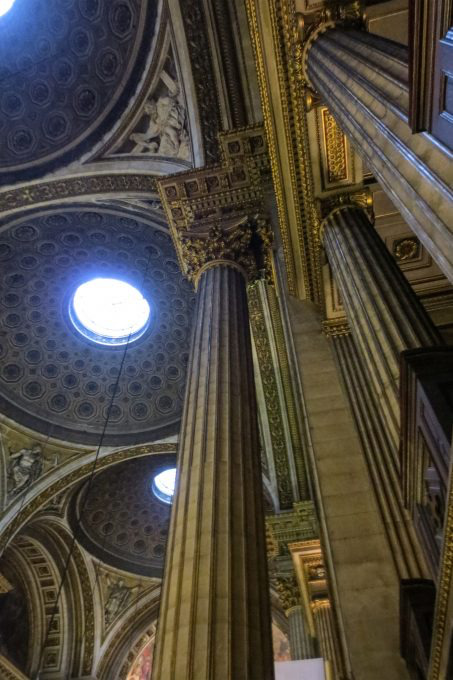

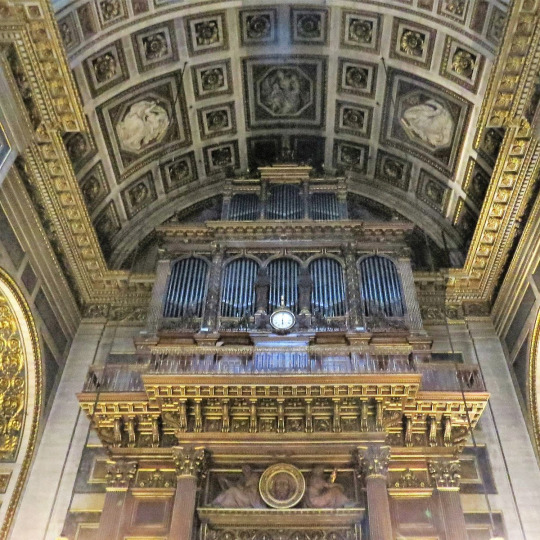

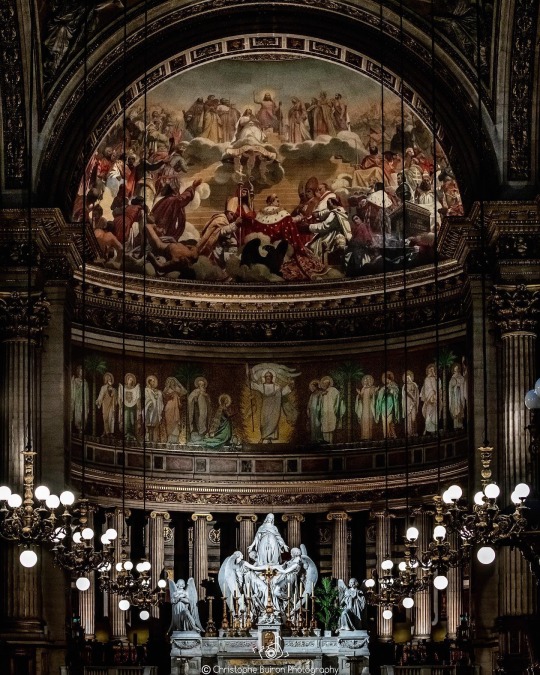

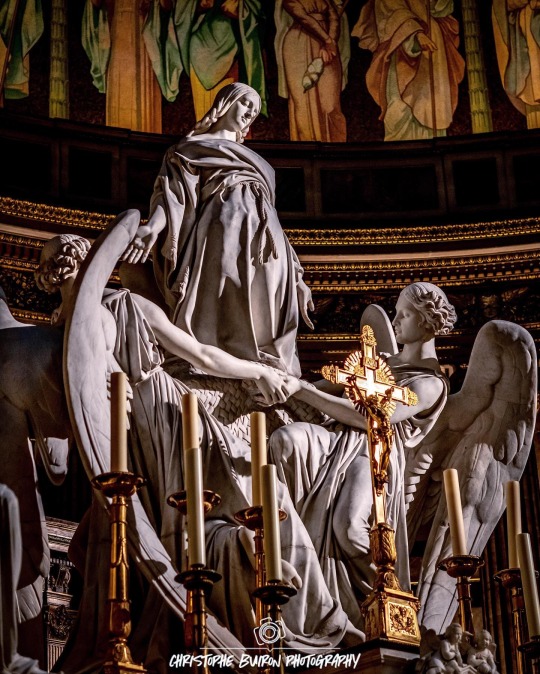
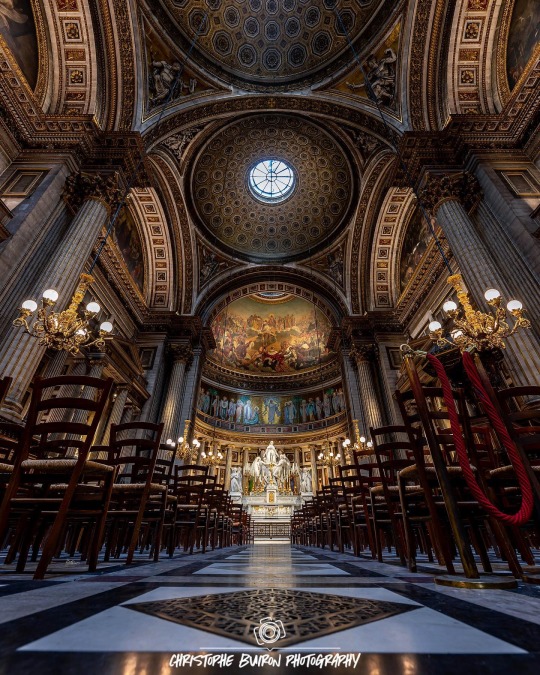
In 1806, Napoleon Bonaparte would sign the decree for the construction of a temple in honor of the glory of the French army: “...it will be the most august and the most imposing of all...Reward with which the victor of kings and peoples "The founder of empires rewards his army."
A competition was called and the project of the architect Pierre-Alexandre Vignon was chosen for the construction of the Church of the Madeleine, Paris. Today considered one of the best examples of neoclassical architecture, its model was the Maison Carré (Roman era).
Neoclassicism disappears when you enter its interior, where the baroque surrounds the walls, only the coffered vaults remind us of the majestic Pantheon of Agrippa.
Its construction lasted eighty-five years due to political instability in France at the end of the 19th century 18th and early 19th. The political changes of the time caused its use to be modified several times. It was about to be a railway station. Between 1835 and 1837, Jules-Claude Ziegler painted “L'Histoire du christianisme” in the apse and between 1835 and 1857, the Paris-based Italian sculptor Marochetti carved the figure of Mary Magdalene for the altar.
One of the most important pieces of the church is the organ from 1846, the work of Aristide Gavillé-Coll.On the outside, the 52 Corinthian columns give it an imposing appearance and support the pediment, the work of the sculptor P. Lemaire, which represents The Last Judgment, which was made in 1833.
Fhoto ©️Buiron Christophe
249 notes
·
View notes
Text

The Love Song
Artist: Edward Burne-Jones (English, 1833–1898)
Date: 1868-1873
Medium: Oil on canvas
Collection: Metropolitan Museum of Art, New York City, NY, United States
Description
This oil painting occupied Burne-Jones from 1868 to 1877. A consummate achievement of Victorian art, it fuses a reverence for Venetian Renaissance painting with a distinctly Aesthetic sense of the connection between music and love. Cupid, personifying Love, slowly squeezes the bellows of a portable organ played by a maiden whose music bewitches her lover, an armor-clad knight.
The composition was first created as a design for the decoration of a panel in an upright piano given to Edward and Georgiana Burne-Jones on their marriage in 1860. Georgiana was an accomplished singer whose repertoire included folk songs and medieval music as well as modern pieces; the title of the painting may derive from a traditional Breton song “Hélas! Je sais un chant d’amour / Triste ou gai, tour à tour.” The composition was also used for a watercolor of 1865 (now in the Museum of Fine Arts, Boston). Most revealing, however, is a portrait of his mistress, the sculptor Maria Zambaco (1870), in which a tiny version of Le Chant d’Amour is shown, as an illustration to an illuminated manuscript she has been reading. Burne-Jones perhaps identified himself as the lovesick knight.
The style of the work is much influenced by Venetian art, and especially the so-called Concert Champêtre in the Louvre in Paris, then thought to be by Giorgione. This richly toned pastoral scene depicted courtiers playing music outdoors, attended by female nudes. It was in an essay on “The School of Giorgione” in 1877 that the Aesthete Walter Pater coined the phrase “all art continually aspires to the condition of music.”
Le Chant d’Amour was shown in 1878 at the Grosvenor Gallery, the preeminent exhibition space for the Aesthetic Movement. In Gilbert and Sullivan’s Patience, the Aesthetic poet Bunthorne declares himself to be “a greenery-yallery Grosvenor Gallery / Foot in the grave young man,” a reference to Burne-Jones’s muted coloring and enervated male figures.
#oil painting#musicians#singers#women#man#love#song#edward burne jones#english artist#metropolitan museum of art#fine art#artwork#english culture#garden#flowers#harp#pre raphaelite movement#european art#19th century painting#pre raphaelite style
35 notes
·
View notes
Text

"The Martyrdom of Saint Denis, Bishop of Paris", Leon Joseph Bonnat (1833 - 1922), French
23 notes
·
View notes
Photo

🥒 Choix des plus belles fleurs: . Paris: Ernest Panckoucke,[1833?].
136 notes
·
View notes
Text

Félicien Rops (1833–1898)
Rops was a gifted artist who shocked people with his erotic paintings of lecherous priests and Parisian prostitutes.
After his marriage broke up, he lived with two sisters in Paris.
53 notes
·
View notes
Text

Léon Bonnat (1833–1922), French. Samson's youth (1891).
Bonnat was born in Bayonne, but from 1846 to 1853 he lived in Madrid, where his father owned a bookshop. While tending his father's shop, he copied engravings of works by the Old Masters, developing a passion for drawing.
Bonnat won a medal of honour in Paris in 1869, going on to become one of the leading artists of his day. Bonnat went on to win the Grand Officer of the Légion d'honneur and became a professor at the Ecole des Beaux Arts in 1882. Bonnat was quite popular with American students in Paris. In addition to his native French, he spoke Spanish and Italian and knew English well.
Bonnat never married, and lived for much of his life with his mother and sister in the Place Vintimille (renamed Place Adolphe-Max in 1940). He died in France on September 8, 1922 (aged 89).
(Don Bryson publication)
26 notes
·
View notes